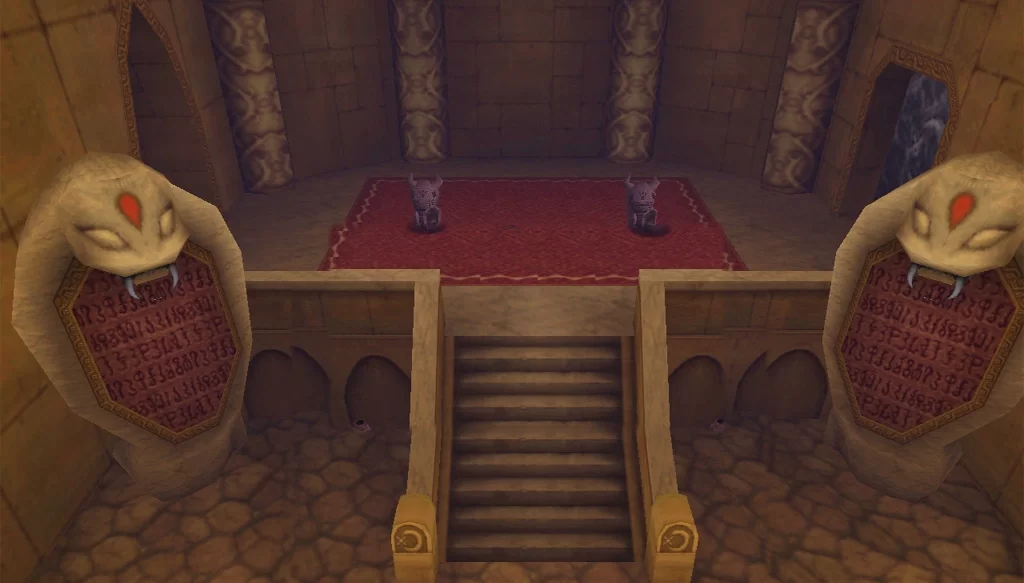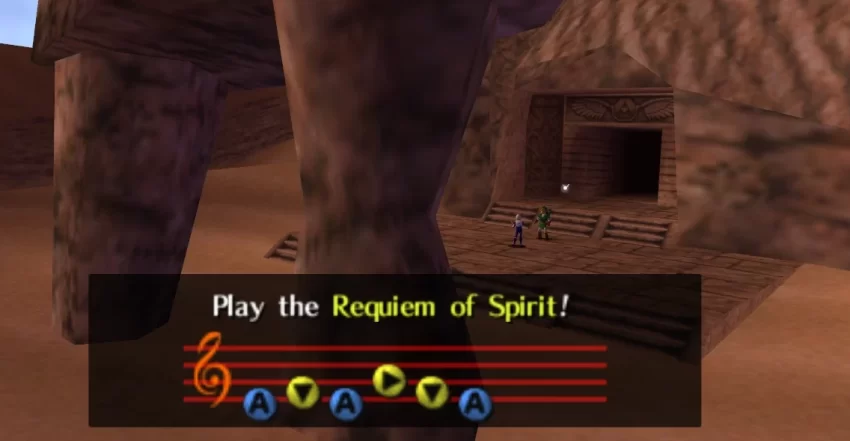The Spirit Temple Is Ocarina of Time’s Most Versatile Dungeon
Posted on January 22 2023 by Sean Gadus

What makes a satisfying dungeon is a great question for Zelda fans to discuss. This is a complex discussion because the elements that make a great early dungeon and the elements that make a great late-game dungeon are quite different. The early dungeons in Zelda games are often designed to teach the player the language of puzzle solving and to serve as tutorials for how to navigate a complex collection of rooms and floors. Yes, these early dungeons still need to have some type of challenge, and perhaps even stump the player at different points, but their main goals are to teach the player the rules for dungeons and puzzle design. In contrast, late-game dungeons should give the player a sense of challenge and include a diverse set of puzzles and tricks within them. These dungeons need to engage seasoned players who are nearing the end of their experience with a specific Zelda game.
The sequencing or progression of Ocarina of Time‘s dungeons is a key element of what makes the game so great. The first three dungeons build the foundations for how a player explores a dungeon, and these early dungeons teach the player how to navigate these complex three-dimensional spaces. For example, Inside The Great Deku Tree teaches the player the basics for climbing vines, timer switches, moving blocks, swimming sequences, and torch puzzles. The other child dungeons, Dodongo’s Cavern and Inside Jabu Jabu’s Belly, follow a similar approach of teaching the player how to navigate increasingly complex spaces. When Link becomes an adult, the designers and developers of Ocarina of Time fully take off the training wheels. The dungeons become more ambitious; the spaces that the player navigates become more complex and elaborate. Yet despite the advancements in complexity and the accumulation of different design ideas, the temples never feel overwhelming (with the possible exception being the Water Temple). It is a testament to the designers and developers of Ocarina of Time that the progression and challenge from dungeon to dungeon feels natural and comfortable.
While the Forest Temple stands out as arguably Ocarina of Time‘s best dungeon, I would argue that the Spirit Temple is Ocarina of Time‘s most complete and versatile dungeon. Positioned as the final leg of the game’s Medallion quest, the Spirit Temple is a brilliant dungeon that requires the player to use almost all of the game’s accumulated items to progress. The only dungeon that features a child and adult section, this super-sized dungeon includes well-designed puzzles, exciting mini-bosses, and an iconic boss fight. In a game that has remained a milestone in gaming history, the Spirit Temple is one of Ocarina of Time‘s best sections.
Ocarina of Time‘s Final Frontier

By the time the player gets to the final stretch of Ocarina of Time, they might find it hard to imagine that the game has any new ways to surprise the player. Ocarina of Time‘s time travel mechanic allowed the developers to reuse different locations for multiple purposes, which in turn allowed the designers to fit an incredible amount of interesting landmarks and dungeons into what is now considered a modestly sized game world. The first four temples (Forest, Fire, Water, and Shadow) require the player to return to areas that Link has already visited as a child. The game hides its temples in plain sight; the process of finding the first three temples is more about revisiting old locations with new tools than filling in blank sections of a map. Narratively, revisiting old locations helps the player reflect on the idea of time, which is the subject of many of Sheik’s monologues throughout the game. While reusing locations is a brilliant use of design space, by the end of the Shadow Temple, it feels like the game has revealed most of its secrets.
The only temple that requires exploration of a new region is the Spirit Temple. Because of this, the approach to the final dungeon is an exciting trip into the unknown, a journey into a wild and unexplored area of the game. This is also why the Gerudo region (Gerudo Valley, Gerudo Fortress, Haunted Wasteland, Desert Colossus, and The Spirit Temple) is my favorite area in Ocarina of Time. Much of the North West section of the game world is inaccessible until Link becomes an adult. While the player can complete Gerudo Fortress early (using Epona or The Longshot) or reach the Desert Colossus early (using the Lens of Truth), the Gerudo Region is essentially Ocarina of Time‘s final frontier; it is the last area of the map to be filled in. By itself, the Gerudo Fortress is a great mini-dungeon. The labyrinthian stealth mission is home to some of the best combat encounters, and it is a more fleshed-out version of the stealth sections seen in Hyrule Castle. The trek across the Haunted Wasteland feels ripped straight from mythology, with Link being ferried across the inhospitable desert sands by a ghost. This trek across the hostile desert recaptures the joy of discovery that is such a core element of the player’s experience as child Link. And as the player emerges out of the Haunted Wasteland, the camera zooms in on the massive Desert Colossus, and it becomes clear that the game still has a few exciting surprises left to offer us.
Fateful Symmetry

In addition to taking the player to a lush, unexplored region of the map, the Spirit Temple is the only dungeon to utilize child and adult Link in the same dungeon. The temple is neatly split into two separate, similarly constructed sides. The western (left hand) section must be completed as child Link, before Link can progress to the eastern (right hand) section as adult Link.
The symmetrical design of the Spirit Temple makes the dungeon quite simple to navigate. The initial entrance hall gives the player a simple choice of left or right, and the massive central room is a great navigational tool as well. While some may argue that the two separate sides make the dungeon too easy to navigate, I would argue that there is a value in having different types of dungeon layouts. While dungeons like the Water Temple are about the complexities of finding your way around a massive open-ended 3D space, the Spirit Temple is more about progression from the bottom to the top (a design idea also featured in the Fire Temple). There is a natural sense of progression as Link rises from floor to floor before facing an Iron Knuckle in order to obtain the dungeon item.
By including child and adult sections, the temple is able to provide one of the most interesting and diverse sets of challenges in Ocarina of Time. The child side consists of some interesting puzzles that utilize child Link’s tools. Players who wanted more challenges or puzzles as child Link get one final chance to use items like the Slingshot and Deku Sticks. The torch puzzle in the Spirit Temple harkens back to the early dungeons in Ocarina of Time, while layering new sets of obstacles like Sun Switches, Blade Traps, and Beamos. While I wish Ocarina of Time had more sections that required both child and adult Link to complete, the inclusion of the time travel mechanic in the Spirit Temple differentiates it from previous dungeons.
A Variety of Puzzles and Challenges

Variety is king in the Spirit Temple. The temple requires the player to use their full arsenal of tools to complete the dungeon. There are eye switches for the bow, a rusted switch for the Megaton Hammer, fake walls and doors for the bombs, and distances that require either the Longshot or hover boots to cross. In short, the designers of the Spirit Temple give the player the opportunity to utilize almost every item that the players collects throughout the game. This dungeon is also the debut of the 3D version of the Mirror Shield, an item that remains essentially the same in Majora’s Mask and The Wind Waker. The final puzzle in the Spirit Temple requires the player to manipulate light through multiple mirrors to lower a platform into the temple’s main hall. Brilliantly, the boss room is hidden behind the grand statue in the main hall, with the player using the Mirror Shield to clear the path to the boss door.
In addition to the excellent set of puzzles, the game also provides the player with some of the most entertaining combat encounters in the game. The child portion of the Temple includes a Stalfos, which looks hilariously large in comparison to the tiny child Link. The game also brings back Lizalfos from Dodongo’s Caverns in several places across the Temple. The crowning achievement is the trio of Iron Knuckle fights. The hulking Iron Knuckles take three full hearts each time they hit the player with their mighty axes. The three Iron Knuckle fights are thus fun tempo battles, pitting the Iron Knuckle’s strength against Link’s speed and agility. The player has to decide how aggressively they want to attack the slower armored foe. If a players stays too close to the Iron Knuckle for too long, it can be devastating; or the player can use the newly acquired Nayru’s Love (found in the Desert Colossus) and throw caution to the wind.
Wicked Witches of the West

The confrontation between the player and Twinrova (Kotake and Koume), the surrogate mothers of Ganondorf, is a great piece of small-scale storytelling. Even though they only appear in one dungeon, there is a clear series of encounters between Link and the witches that build anticipation for the climatic boss battle. The player first encounters Kotake and Koume after obtaining the Silver Gauntlets. The ensuing cutscene shows the witches capturing Nabooru before returning to the Spirit Temple. This cutscene effectively illustrates that the witches are powerful and dangerous. The player next encounters the witches after entering the boss chambers. In a fun surprise, the witches test Link’s mettle by forcing him to battle a brain-controlled Nabooru in a prelude to the real boss fight. Kotake and Koume even have their own musical theme, a sinister yet playful song that helps drive home Twinrova’s mischievous and evil personalities. After the player proceeds to the boss chamber, an ominous chamber filled with mysterious carvings and symbols, the witches sinisterly emerge for a final battle against Link. Their introductory lines — “With my flame, I will burn him to the bone,” and, “With my frost, I will freeze him to his soul,” — set the tone for the epic battle against two twisted and evil sisters.
Like Phantom Ganon before them, the battle against Twinrova feels designed to show off the new 3D space that Ocarina of Time was built around. With Kotake and Koume rotating their positions around the player, the player has to adjust the camera and keep moving around the arena to succeed. Unlike most boss fights which allow you to concentrate fully on one enemy, Twinrova requires the player to track both witches simultaneously and watch out for their respective attacks. It takes some patience for the player to catch the witches in the same frame, which gives the player a chance to use of one of their powers against the other. The sisters each deal a sizeable amount of damage to Link, so the fight feels appropriately challenging, especially if a player has not been seeking out additional Heart Pieces or bottles. The second stage of the fight is not nearly as interesting as the first half. The player has to absorb either fire and ice three times and then send it back at Twinrova. As long as the player is paying attention, the fight is very simple, which is a bit disappointing.
The final cutscene between Kotake and Koume is one of the funniest moments in the Zelda series. Not realizing that Link has defeated them, the witches begin to berate him, only to realize they are both sporting halos. The twins begin to bicker as Koume lies about her age, which Kotake quickly calls her out for. Finally, Kotake and Koume are ushered into the afterlife, and they leave Link with the threat that they will “come back to haunt you.” The silly nature of the scene feels very unexpected, and the scene further illustrates the twins’ mischievous personality, something that is missing from many other encounters with Zelda bosses.
Conclusion

Almost twenty-five years since it was first introduced, the Spirit Temple still stands as one of the most engaging dungeons in the Zelda series. Earning the #7 spot in Zelda Dungeon’s own “Best Zelda Dungeons” list in 2020, the dungeon takes full advantage of its position as one of the last dungeons in Ocarina of Time by creating a strong collection of puzzles that make use of almost all of the game’s items. With three mini-boss battles and a stellar boss battle, the dungeon provides a suitable level of challenge for the player. Additionally, the temple is the only dungeon in the game to take full advantage of the time travel mechanic that is a core part of Ocarina of Time‘s story and gameplay. In short, the Spirit Temple has earned its status as one of the best dungeons in the Zelda series.

Sean Gadus is a Senior Editor at Zelda Dungeon. His first Zelda game was Ocarina of Time, and he loves all of the 3D Zelda games from 1998-2011. The final battle of Tears of the Kingdom is one of his favorite final battles in the entire series. He wants to help build a kinder, more compassionate world. You can check out his other written work at The-Artifice.com.



